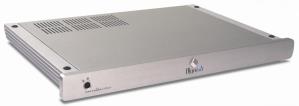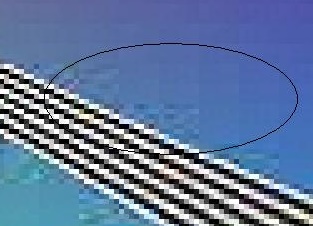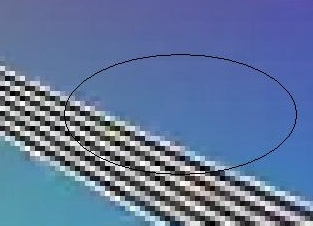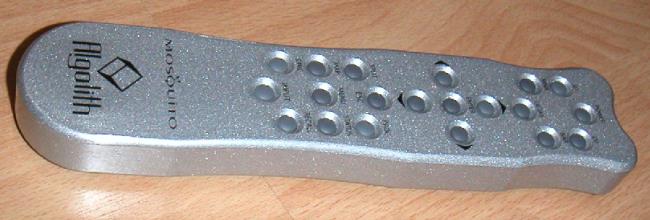|
|||||||||||
|
Introduction In the beginning, there was analog television, and it was bad. But, over the years, people have gotten used to noise, ghosting, and other analog video problems. From the broadcaster's perspective, analog video required too much bandwidth. A satellite could only carry 6-10 analog TV stations, which made satellite TV expensive and rare. With the advent of digital electronics, a group called the “Moving Picture Experts Group” (MPEG for short) put together a set of standards for compressing digital video and audio. This compression is used everywhere today (technologies like DVD, satellite TV, and MP3 are all derivatives of their standards). One major purpose for these standards was to fit more TV stations onto a single satellite's total bandwidth. Today's satellites squeeze in more than 10 times as many digital TV stations as they could have with the old analog ones. A side effect of this technology is that digital mediums no longer suffer from analog noise or ghosting, and the picture looks cleaner than ever before. To achieve its magic, MPEG compression attempts to throw away information that the eye doesn't quite notice. With enough bandwidth, an MPEG signal can look almost identical to the original image. Cable companies joined in too and are now using this technology for cable television. The problem is that consumers pay more for quantity than they do for quality. Most Satellite and cable companies charge us per station – so it's in their best interest to send us more stations through the same satellite or cable. As a result, more and more compression has to be used, and that creates artifacts. DCT – Discrete Cosine Transform Imagine the satellite as a large water pipe with lots of little pipes (channels) inside. Only so much water can go through. If we want to fit more channels (little pipes) into the large one, each channel (little pipe) has to be smaller and gets less water (or bandwidth, if you will). The satellite companies can control how much water each station uses, but the total amount of water/bandwidth through the pipe - is always constant. The basis of MPEG (and many other technologies, such as DVD, Windows Media Video, TiVo, ATSC) is a technology called DCT, or Discrete Cosine Transform. The idea is to divide the image into blocks (8x8 pixel squares) and macroblocks (16x16 pixel squares consisting of 4 blocks). Compressing the image, so it can squeeze through the pipe, is done by trying to estimate and predict where and how these blocks will move. Obviously, the estimates are not perfect, so the difference between the prediction and actual image is also evaluated and sent. The result is a close approximation of the original video image. The more bandwidth we use for the video bitstream (more bits per second), the closer the approximation will be to the original video. As cable and satellite companies need to give us more channels and collect more revenue, the quality of each individual station suffers. We start getting “video artifacts”. Satellite companies are forced, by law, to carry local television stations that are targeted for localized audiences. These are a special kind of headache for the carriers, as these stations are less popular and there are so many of them. The solution for the satellite companies is to compress the bitstream for these stations as much as they can, so they take up less bandwidth on their satellite. There are two main “video artifacts” that occur for DCT compressed sources when they are “bit-starved” (i.e., they're not getting enough bandwidth). The first artifact is called “Macroblocking”. Areas with slight differences in color cause nearby block and macroblocks to be tinted differently. Background areas (e.g., images of blue sky or green fields) and dark areas in the image are usually affected the most when the bandwidth is too low. The artifact makes the image appear “digitized” and unnatural. The photo below shows Macroblocking on the left, while on the right, Macroblocking has been filtered out, using the product under review here, the Algolith Mosquito.
The second artifact is called “Mosquito Noise”. This artifact appears as specs around edges of objects. With a bit of imagination, one could imagine a swarm of mosquitoes around people's faces, channel logos, or even subtitles. The more compressed the image, the more noticeable mosquito noise becomes. In the photo below, the left image shows Mosquito Noise at the edges of the subjects' shirts, where the shoulders meet the dark background. On the right, Mosquito Noise has been filtered out by the Algolith Mosquito.
Here are additional examples. The photo on the left has
Mosquito Noise, and the photo on the right is processed to remove the noise.
Quality vs. Quantity A few years ago, HDTV became the next buzzword, and we're finally seeing lots of HDTV programs, and more and more consumers are buying displays that will show them. Unlike SDTV (Standard Definition TV), the picture quality of HDTV sources is usually fantastic. However, as more HDTV stations are being introduced, HDTV is bound to suffer the same fate as SDTV. HDTV stations use exactly the same compression technology as SDTV and if bitrates decline, the same problems we've been seeing in SDTV compression will also occur in HDTV. New HDTV formats are coming, but regardless of which format ends up winning, all of the new formats are DCT compression-based. DVDs, Over-the-Air receivers, HDTV receivers, satellite STBs, D-VHS, TiVo, HD-DVD and BlueRay are all based on DCT compression and all suffer from these two artifacts! Solution? Well, the simple solution is to use something called a blur filter. This type of filter simply masks these artifacts by blurring the image. It eliminates the artifacts, but it also feels like you're wearing someone else's glasses. The real trick is to remove just these artifacts without making the picture look soft. Algolith, originally a small group within Miranda dedicated to researching solutions for DCT based artifacts, was created to produce products to scrub out such artifacts. The idea is to specifically target the main two problems with DCT compression and fix them with little or no impact on the rest of the image. Algolith focuses on implementing the technology in various ways: plugins for video editing systems and hardware platforms, as well as integrating the technology into various types of equipment (e.g., Samsung has licensed the technology to implement in its equipment). The Algolith Mosquito One answer for home users suffering from Mosquito Noise and Macroblocking is the Algolith Mosquito, a standalone video processor dedicated to removing these two problems. How does it work? The technique sounds easy enough. First, the system determines where the problem is located by mapping out the different areas in the image: where edges are located, where detail is located, and where the artifacts are located. The Mosquito then focuses on the visible artifacts and makes them less pronounced. Because they can tell where actual detail is located, the resulting picture does not appear fuzzy or soft. So, the Mosquito does not invent or recreate the original data, it simply modifies the image in very specific areas where the artifacts are located and fades them away. Because it can target just the artifacts, the rest of the image appears as rich, detailed, and sharp as ever. The Mosquito I tested was a PAL (576i, 576p) unit, and not all of the PAL features were fully operational, but as the unit is firmware upgradable via a USB port, that is no problem. The unit features two component inputs, that support both HD and SD sources of all major video formats (NTSC, PAL, ATSC). The Mosquito is powered by a wall wart. European consumers will want to use the system with an RGBcvS (SCART) to component transcoder such as the one produced by John Sim (www.rgbtosvideo.com).
The remote is very heavy, and its range is limited. However, as the unit is primarily designed to be set up and used in between the source and display device (or processor), these are not critical issues.
In Use The first thing I noticed when getting the Mosquito was how aesthetically pleasing the unit was – it is 1.5” thin (less than 1U!) and it is simply a pleasure to look at. The front of the unit has no buttons or functions, and every feature is only accessible through the remote control! The unit I was using was a beta PAL unit, but by the time you read this, Algolith should already be delivering production ATSC/NTSC/PAL units. I don't believe people using the Mosquito will be continually tweaking it. Those that will, are more likely to use it with universal remotes. The unit contains several memory storage blocks that allow you to save a complete configuration and quickly retrieve the configuration from it. This will be particularly useful when Algolith releases discrete IR codes that will allow Pronto users to quickly switch settings from “Noisy DVD”, “Overly Compressed DVD”, to “No Pprocessing”. One of the memory blocks (block 0) contains the factory settings, which is a nice idea. I found that the best settings for my own typical viewing were with most of the settings dialed down to fairly low values (but not turned off). Using this setting, the image was considerably more pleasant and stable than without the unit. The settings include various filters, such as 2D (blur), 3D (temporal), MNR (Mosquito), BAR (Macroblocking), and Detail Enhancement. The latter was my least favorite, as it serves to artificially enhance edge detail. Apparently, the majority of the HT enthusiast population apparently disagrees with me and likes enhanced edge detail. I discussed this point at length with Algolith's representatives at CES and the feedback they received from customers was an overwhelming preference for this feature. After turning off detail enhancement, the difference was quite clear. To help emphasize the difference, the unit comes with a split screen feature that lets you see processed and unprocessed images side by side. Noisy areas of the screen, and in particular areas with flickering noise, turned extremely stable without significant softness. The most interesting thing was how the Mosquito did not ruin good pictures, but was able to improve bad ones! The Mosquito uses different filters depending on the various areas on the screen. Using a special “Map Detection Region” mode, you can see how the system determines where image edges, macroblock edges, and detail are located on the screen. Comparing the image with a straight component input (the test was conducted with a Panasonic DVD player lacking the chroma bug) revealed almost no loss in sharpness when compared with the processed Mosquito signal. I found that feeding a progressive signal (i.e., having the Faroudja chip in the Panasonic DVD player perform de-interlacing prior to the Mosquito) produced a better looking image with less artifacts. I used the Mosquito in conjunction with various scalers, in order to test if the unit would cause them problems with cadence detection. Except for occasional irregularities, I found no evidence that the unit caused problems with scalers. It should be mentioned that the Mosquito has to be connected before scalers, if these are in use, as scaled images will not be processed correctly (because the artifacts will also be scaled accordingly). During CES - 2005, Algolith unveiled a new version of the Mosquito, which contains HDMI inputs in addition to the existing component inputs. I found that the picture quality was better when the unit was fed progressive signals (480p), because it was able to remove a few more artifacts when given this resolution. The primary benefit for the Mosquito in my system was in making SDTV STB sources more palatable. I found that removing it from the video chain brought back a lot more artifacts than I remembered. You can become used to the processing very quickly and only realize the impact of the change after removing the Mosquito from the chain. For people who can live with a softer image (smaller displays like LCD or plasmas), setting a slightly higher noise reduction makes the image more pleasing, but it does soften details in the image. In such cases, the detail enhancement feature can slightly counteract this additional filter. The settings are very personalized and I doubt two people will end up with the same set of filter values. Conclusions The Algolith Mosquito is an excellent product, and has a fair price in keeping with high end video processors out there. Although noise reduction is available in one form or another on some DVD players and processors, the increased flexibility of the Mosquito makes it a valuable addition to any good video system.
Mr. LaOr is Editor of Hometheater.Co.Il, a Hi-Fi magazine published in Israel. He is also the moderator for the AVS Forum Video Processing section.
|
|||||||||||











